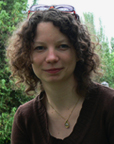
|
BMe Research Grant |

|
PhD School in Psychology
Department of Cognitive Science
Supervisor: Ilona Kovács, external advisor: János Geier
Brightness and Colour Illusions
Introducing the research area
Brightness illusions reveal much about the mechanisms of light intensity processing in the visual system. Similarly, colour illusions provide an insight into colour processing. My research topic is related to the computational model developed by my external advisor, János Geier (abstract: 2009, paper in prep.) This model aims at building a unified explanatory principle for all brightness illusions by developing an algorithm that can simulate both contrast and assimilation phenomena as well as real images without changing their parameters.
I investigate the regularities of these illusions by means of psychophysical experiments.
Brief introduction of the research place
My research is carried out at two sites. In the Department of Cognitive Science at BME, where a wide range of topics in cognitive science is investigated, from the perception of contours through the effects of sleep on learning to psycholinguistics. The external site is Stereo Vision Ltd., which conducts experimental research on the basic processes of human vision and also models them computationally, applying results to the development of innovative image processing algorithms.
History and context of the research
A common feature of brightness illusions is that perceived brightness relations differ from physical brightness intensities. Illusions convey information on the basic mechanisms of brightness perception. Since these illusions are " errors" of the visual system, conclusions can be drawn about the working principles of perception by scrutinizing and modelling their regularities.
Brightness illusions can be classified as contrast (Fig. 1.) and assimilation (Fig. 2.) phenomena. In the case of contrast phenomena, an area when inserted in a bright environment appears darker, but brighter in dark environment. Assimilation phenomena are the opposite: grey areas in bright environment appear brighter than those surrounded by dark areas.
In our days, there is no unified model to describe contrast and assimilation phenomena. Contrast phenomena are traditionally explained by lateral inhibition (Fig. 4.), claiming that stimulation of the periphery inhibits neural response within a small retinal area, while stimulation of the centre enhances it (Baumgartner, 1960; Goldstein, 2009). Nonetheless, this explanation cannot describe assimilation phenomena. Low level explanations (i) try to capture these illusions by convolution models (e.g. Blakeslee & McCourt, 2004). These models substitute intensity of each pixels by a weighed sum of intensities in their local environment. (ii) Some theorists of the filling-in approach (e.g. Cohen & Grossberg, 1984) search for the edges in the image and fill in the enclosed areas. Others emphasize the role of interpretation of image details (Adelson, 1993).
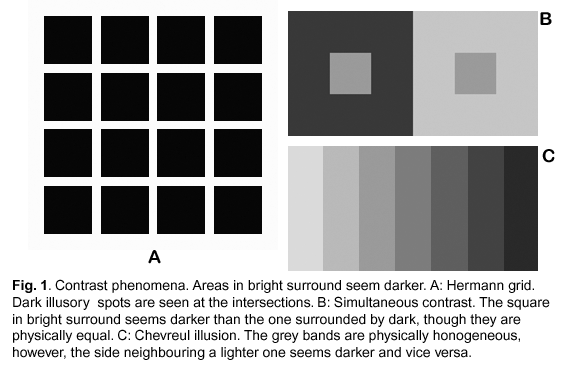
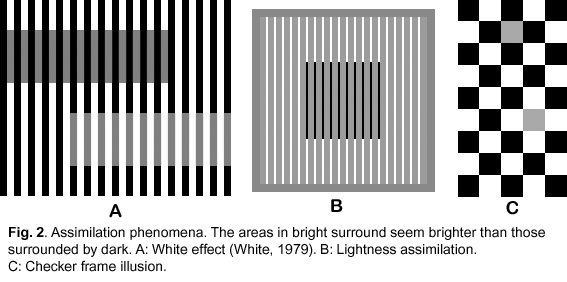
Aim of the research
The aim of my research is to investigate regularities of brightness and colour illusions by means of psychophysical experiments. These results will be applied to psychophysically validate and improve Geier's computational model (2009). The aim is to capture both assimilation and contrast phenomena by a unified model.
Measuring the extent of each illusion and scrutinizing their dependence on different image parameters may provide new ideas for the development of a model capable of simulating all brightness phenomena known to date, including contrast and assimilation.
Based on theoretical considerations, the application of a unified parameter combination is of high importance, as seemingly opposite effects can be observed at phenomenon level (it is still unclear what phenomenon occurs under a given circumstance (Gilchrist, 2006)), yet the nervous system cannot be assumed to switch from “assimilation method” to “contrast method” on recognizing the image. It is more plausible therefore, to suppose the use of the same processes when looking at pictures producing assimilation or contrast phenomena or real ones.
I also plan to investigate the chromatic version of these illusions experimentally, whereby we can generalize the simulation model to colour illusions and real chromatic pictures. Thus we aim at capturing human brightness and colour perception within a unified framework, including the exact simulation of the errors of the visual system revealed by illusions.
Methods
1. Brightness illusions
In my psychophysical experiments I vary the image parameters of the illusions to identify the parameters necessary or sufficient for the particular illusion to occur, and investigate the effects each parameter change causes. For this purpose, I mainly use the cancellation technique, where the subject has to modify the image presented on a computer screen until the illusion disappears. In this way, I measure the extent of each illusion, depending on the image parameters.
In the case of White effect, for instance, I will investigate the line widths where the illusion is more pronounced; the effect of the proportion of height and width of the grey targets as well as the circumstances under which the illusion reverses to simultaneous contrast. Also, I will investigate from this perspective the illusions related to the White effect and simultaneous contrast, such as the circular White effect, the Bulls eye illusion or a new variant of White effect lacking edges, discovered by us (Hudák and Geier, 2009). The role of edges will be of utmost importance in my research, since it is a key issue for the model. Therefore, I will continue investigating the segmenting role of edges by varying the ramped and double-ramped versions of the Chevreul illusion published by us (Geier, Séra, Bernáth and Hudák, 2006). Of the brightness illusion, an important role will be assigned to the Craick-O’Brien-Cornsweet illusion, in which all areas are equally grey; the illusory lightening-darkening is caused merely by the gradient lightness profile of the edges in the image.
2. Colour illusions
Earlier, we modelled colour illusions by processing red, green and blue channels independently, which proved successful for the chromatic Hermann grid, Lotto illusion and colour contrast. Validity of the model for the chromatic Hermann grid was verified empirically (Hudák and Geier, 2007). In the meantime, we have discovered that the principle of independent processing of the three channels does not model neither the chromatic version of the White effect nor the Munker illusion in all colour combinations, and that the simulation result does not match with human perception in the case of Pinna illusion, where the entire image is white with the edges showing a yellow-purple gradient. As a consequence, some areas in the image look yellowish, and others remain white. We plan to complete or reconsider the chromatic model to enable it simulating all colour illusions with uniform parameters.
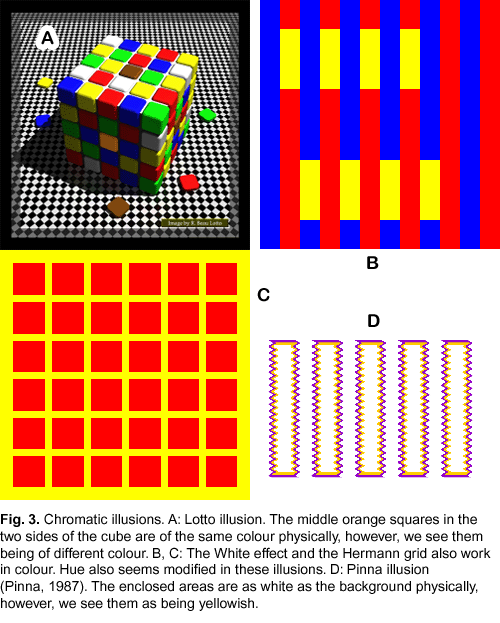
Results
To develop a new unified model and to make it known to the scientific world, the first step is to refute the generally accepted old model decisively. I have described above the principle of lateral inhibition, which has been treated in the literature identical with the working mechanism of retinal receptive fields since 1960. A great proportion of contrast phenomena is explained in these terms by textbooks; convolution models, too are based on it, and theorists assuming higher level cognitive processes in brightness perception trace back assimilation phenomena to lateral inhibition as well, by supposing the involvement of grouping principles (Gilchrist, 2006).
We refuted this textbook explanation for the Hermann grid in our paper published in Perception, by curving the streets of the grid. We have also given the qualitative description of our model in that paper.
We have extended the model for chromatic Hermann grids. I presented these simulation results in my talk at the ECVP conference in 2007.
We have also refuted the textbook explanation and all convolution models for the Chevreul illusion (Geier, Séra, Bernáth and Hudák, 2006; Geier and Hudák, paper in preparation).
I also had a closer look at the physiological support of the traditional explanation. I analyzed the most significant publications on the measurements of retinal receptive fields. However, I did not find the scientific evidence for the classical explanation in the literature (Hudák, submitted).
The computational model developed by Geier (2009; paper in prep.) is now suitable for simulating 80% of the known brightness illusions without changing its parameters. With a slight parameter change, it can simulate 95%, including those for which other theorists consider higher cognitive processes necessary.
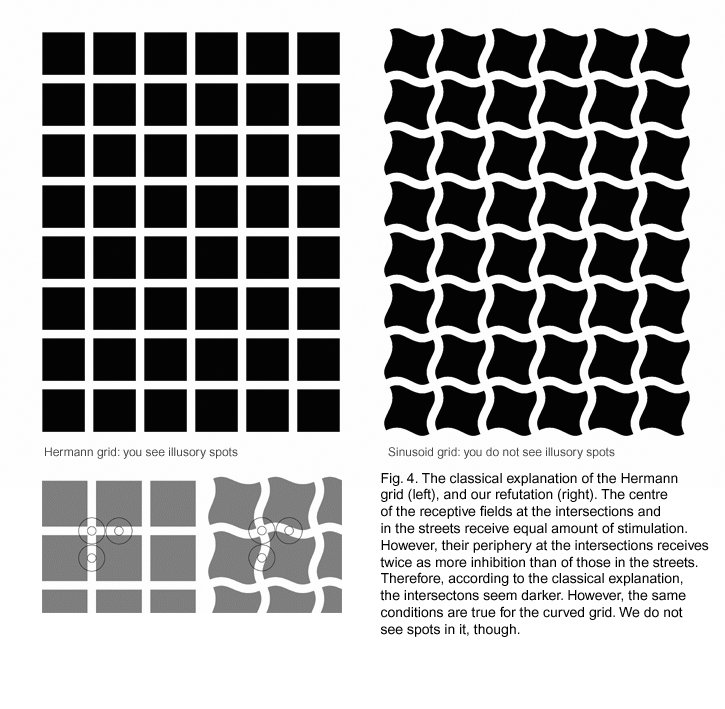
Expected impact and further research
Our results refuting the classical model have already gained international reputation (Anstis 2006, Bach & Poloschek, 2006; Hoffman, 2008; Howe & Livingstone, 2007; Lingelbach & Ehrenstein, 2004; Schiller & Carvey, 2005). The publication of the new model will probably be of great interest, since models known today can account for only a smaller proportion of illusions, and none of them have been extended to chromatic pictures. In our further research, the development of brightness and colour perception will play a role besides the scrutiny of dynamic phenomena and spatial vision, which we aim at capturing by a similarly exact computational model, based on the results of our future psychophysical experiments.
Publications, references, links
Publications of my own:
International journal publication:
Geier J., Bernáth L., Hudák M., Séra L. (2008): Straightness as the main factor of the Hermann grid illusion. Perception 37(5) 651–665
Links:
http://www.perceptionweb.com/abstract.cgi?id=p5622
http://www.geier.hu/Hermann/index.html
Hungarian journal publication:
Hudák M. (submitted): Receptív mezők a retinán: a pszichofiziológiai mérési adatok kritikai áttekintése a klasszikus világosságillúziók magyarázatának szempontjából. Pszichológia (Receptive fields on the retina: Critical review of psychophysical measurement data with respect to the explanation of classical brightness illusions – in Hungarian)
International conference talk:
Hudák M. F., Geier J., 2007: "Modelling with flying colours: The application of the RadGrad model to chromatic Hermann grids" Perception 36 ECVP Abstract Supplement
Links:
http://www.perceptionweb.com/abstract.cgi?id=v070420
http://www.geier.hu/ECVP2007/CLR-HERMANN/index.htm
International conference posters:
Hudák M., Geier J., (2009): White effect
without physical edges” Perception, 38, ECVP Ab 51
Link:
http://www.perceptionweb.com/abstract.cgi?id=v090994
Geier J., Séra L., Bernáth L., Hudák M. (2006): Increasing and decreasing the Chevreul illusion by a background luminance ramp. Perception, 35, ECVP Abstract Supplement
Link:
http://www.perceptionweb.com/abstract.cgi?id=v060506
Geier J., Séra L., Hudák M. (2007): Whiter than white, blacker than black – overshoot in lightness perception. Perception, 36, ECVP Abstract Supplement
Links:
http://www.perceptionweb.com/abstract.cgi?id=v070418
http://www.geier.hu/ECVP2007/BRI-OVERSHOT/index.htm
Hungarian conference talks:
Hudák M., Geier J. (2009): White-illúzió fizikai élek nélkül (White illusion without physical edges – in Hungarian) 15. Magyar Látás Szimpózium, 18 December, 2009
Link: http://sites.google.com/site/latasszimpozium/Home/kivonatok
Füzesiné Hudák M., Geier J. (2007): A RadGrad modell alkalmazása a színes Hermann-rács foltjaira (Application of RadGrad model to the chromatic spots of Hermann-grid – in Hungarian), MAKOG XV. Eger, Hungary, 19–21 January, 2007
Link: http://www.makog.cogpsyphy.hu/MAKOGprogram.pdf
Séra L., Bernáth L., Geier J., Füzesiné Hudák M. (2007): A Chevreul illúzió változása a háttér rámpa változtatásával, avagy hogyan értelmezünk? (Changes in Chevreul illusion with varying background ramp, or How our interpretation works – in Hungarian), MAKOG XV. Eger, Hungary, 19–21 January, 2007
Link: http://www.makog.cogpsyphy.hu/MAKOGprogram.pdf
Hudák Mariann, Geier János (2008): Receptív mezők, sűrű sötét erdők? (Receptive fields – dark lush forests? – in Hungarian) 14. Magyar Látás Szimpóziumm, Pécs, Hungary, 30 August, 2008
Link: http://kognit.edpsy.u-szeged.hu/latasszimpozium/2008/absztrakt.htm
Hungarian conference poster:
Geier János, Séra László, Hudák Mariann: A vizuális illúziók napjainkban (Visual illusions in our time – in Hungarian), Magyar Pszichológiai Társaság Nagygyűlése, Nyíregyháza, Hungary, 2008
OTDK paper (2nd place):
Hudák M. F. (2006): A színes Hermann rács foltjainak törvényszerűségei (Regularities of spots in the chromatic Hermann-Grid). OTDK dolgozat. OTDK 2007, Piliscsaba, Hungary
Other references:
Adelson, E. (1993): Perceptual organization and the judgment of brightness. Science, 262 (5142), 2042–2044
Anstis, S. (2006): In honour of Lothar Spillmann – filling-in, wiggly lines, adaptation, and aftereffects. Prog. Brain Res., 155, 93–208
Bach és Poloschek, (2006): Optical illusions. Advances in Clinical Neuroscience and Rehabilitation, 6(2), 20–21
Baumgartner, G. (1960): Indirekte Größenbestimmung der rezeptiven Felder der Retina beim Menschen mittels der Hermannschen Gittertauschung. Pflugers Archiv für die gesamte Physiologie, 272, 21–22
Blakeslee, B. &. McCourt M E (2004): A unified theory of brightness contrast and assimilation incorporating oriented multiscale spatial filtering and contrast normalization. Vision Research, (44) 2483–2503
Cohen MA, Grossberg S. (1984): Neural dynamics of brightness perception: features, boundaries, diffusion, and resonance. Percept Psychophys., 36(5) 428–456
Geier J., (2009): A diffusion based computational model and computer simulation for the lightness illusions. Perception (38) ECVP Abstract Supplement, 95
Link: http://www.perceptionweb.com/abstract.cgi?id=v090993
Gilchrist, A. (2006): Seeing black and white. Oxford University Press, New York
Goldstein, E. B. (2009). Sensation and perception. 8th ed., Wadsworth Cengage Learning, Belmont
Hoffmann, K. P. (2008): Faculty of 1000 Biology, 5 August 2008
Link: http://www.f1000biology.com/article/id/1118826/evaluation
Howe, P.,D.,L. & Livingstone, M. S. (2007): The use of the cancellation technique to quantify the Hermann grid illusion. PLoS ONE 2(2) e265.
Lingelbach, B. és Ehrenstein, W. (2004): Neue sinusförmige Variante des Hermann-Gitters. Optikum, 14 December 2004
Link: http://www.optikum.at/modules.php?name=News&file=print&sid=319
Otazu, X., Vanrell, M., Párraga, A. (2008): Multiresolution wavelet framework models brightness induction effects. Vision Research (48) 733–751
Pinna, B. (1987): Un effetto di colorazione. In V. Majer, M. Maeran, and M. Santinello, Il laboratorio e la città. XXI Congresso degli Psicologi Italiani, 158
Schiller P H, Carvey C E, (2005): The Hermann grid illusion revisited. Perception, (34) 1375–1397
White M. (1979): A new effect of pattern on perceived lightness. Perception, 8(4), 413– 416
